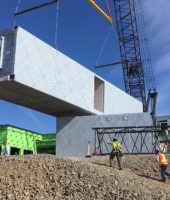
08.12.2019
Top 10 Reasons to Choose Modular Construction for your next project!
Modular buildings are built with all the same materials and to the same building codes and architectural specifications as onsite construction, just completed in an offsite, quality controlled environment. Modular buildings are also built to be able to withstand travel and installation requirements, creating a building that can be more durable than structures built onsite. Here are 10 reasons to consider modular for your next project.
- A shorter build time – With modular construction, site preparation and foundations and the building can be built at the same time. Factory-based pre-fabrication also speeds up the process, giving modular projects a 30%-50% schedule reduction over traditional construction.
- A quicker return on investment – A quicker turn of capital deployed in any project means an improved internal rate of return (IRR). It’s great to open one project early, but when you repeat the schedule reduction on 10 consecutive projects, you find yourself way ahead of the competition.
- Increased cost-savings – Modular construction can cut costs by up to 20% in the right market. A shorter build time saves money on overall construction and finance-related costs. Labor costs are less, as prefab construction uses more factory workers and less individual tradesmen like plumbers and electricians.
- No weather-related construction issues – Construction crews work inside, enabling them to work year-round, no matter the weather. Building materials stay cleaner indoors, where they’re also protected from the elements.
- A solution for difficult sites – For projects in challenging climates with a short construction season, modular is an important avenue to make projects viable. From mountain ski resorts to coastal hotels or student housing complexes near campus, modular is a key solution to difficult sites.
- Limited site disruption – The same factors that make modular work well for difficult environments can also be assets when constructing projects on sites where it’s important to keep business or activity flowing. Vehicle and pedestrian traffic disruptions can be a big challenge for communities with extensive construction happening. Modular decreases this impact with rapid installation schedules.
- Less pollution – Since most materials are delivered to the factory, modular construction means fewer trucks at the project site. Fewer vehicles mean less air and noise pollution.
- Less waste – Off-site modular manufacturing can reduce waste and make it simpler to use lean manufacturing methods and environmental principles during construction. Prefab construction materials, from packaging to steel—are easier to recycle, since they haven’t been exposed to the elements as onsite materials are.
- Easier quality control – On an assembly line, quality control can be monitored in a much more organized fashion. Factory management implements a detailed cloud-based QA/QC program so internal managers and external consultants can get detailed real-time documentation of all components of the modular build.
- Modular Design Can Impress – Modular buildings can be quite simple or architecturally complex. Designers can implement various modular designs that result in an architecturally impressive building.
It’s no wonder modular is considered a construction practice of the future in an industry that has suffered from stagnant productivity and labor challenges. The future is bright for modular construction.
